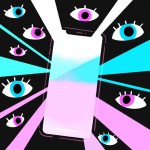If the first thing you did when you woke up this morning was check your phone, you’re not alone.
Nearly 70% of smartphone users begin using their devices within 15 minutes of their alarm going off. Coupled with the fact that the average college student spends around nine hours a day on their phone, the statistics can paint a scary picture.
Smartphones have quickly become integrated into every aspect of our lives by connecting us with transportation, food, resources and essentially, the world. The good news? Managing screen time is now simpler than ever with the assistance of built-in phone usage applications.
This is not a new concept – the App Store and Google Play Store have housed similar third-party applications for years. But now, technology companies are focusing on delivering accurate information about users’ smartphone habits without having to install a separate app.
Apple’s September 2018 system update introduced Screen Time, a feature designed to refocus users and make them aware of their digital habits. For Android users, Google is working on streamlining a feature originally released for the Pixel called Digital Wellbeing.
Accessing Screen Time through Settings allows users to set time limits for app categories, view a breakdown of their daily usage and schedule downtime away from their phone. Digital Wellbeing has similar features, however, usage statistics are compiled into a simple pie chart and time limits can be set for specific apps rather than categories.
As a part of Screen Time, iPhone users receive a weekly notification that displays their average phone usage for the past seven days. Digital Wellbeing weekly statistics can be accessed through Settings, though recent reports indicate the feature is slowing down phones.
First-year psychobiology student Nicolette Khalifian said although the Screen Time feature on her iPhone has made her more aware of her usage, she sees it as a futile attempt for college students who have no one to keep them in check.
“It’s like a positive feedback loop of addiction,” Khalifian said. “When everyone is on their phone, you also go on your phone since you react to people around you.”
Although the Diagnostic and Statistical Manual of Mental Disorders does not currently classify excessive screen usage as an addiction, the compulsion to use smartphones for hours every day could stem from other conditions, such as social anxiety. According to psychologists, the constant need to check one’s phone for notifications can be seen as more of an obsession than an addiction: It’s something to do that does not involve interaction with the real world.
Some smartphone users also feel a compulsion to use their phone because of a condition called phantom vibration syndrome, or “ringxiety.” Since our brains are wired to be attentive of every stimulus, setting your phone on silent can be the first step to curing the itch.
Unsurprisingly, smartphone overuse has also been linked to lower self-reported productivity. The typical student spends around 20% of class time on unrelated digital distractions, according to a study done at the University of Nebraska-Lincoln. For college students who are hoping to get as much out of their day as possible, these smartphone compulsions can act as a chronic obstacle to productivity.
Not only do applications like Screen Time raise awareness about smartphone overuse, but they also allow for self-intervention. An environmentally friendly way to curb overuse and increase productivity is by using an app like Forest that plants real trees in exchange for less screen time. Another simple way to resist the temptation is placing your phone across the room so it’s not within arm’s reach in the morning.
Some students worry that these applications are technology companies’ veiled attempts at gathering data on which applications are most addictive. Third-year English student Shayna Freedman said if her Samsung were to incorporate the Digital Wellbeing feature, she would not use it.
“Most companies are not really out for your wellbeing,” Freedman said. “I think it’s just a fad to tell people how much time you spend on your phone.”
Smartphones tend to get a bad rap, but really, it’s up to the user to determine how much precious time they want to give to an aluminum rectangle. If you can’t remember the last time you introduced yourself to a stranger while waiting in line, try putting down your phone.
